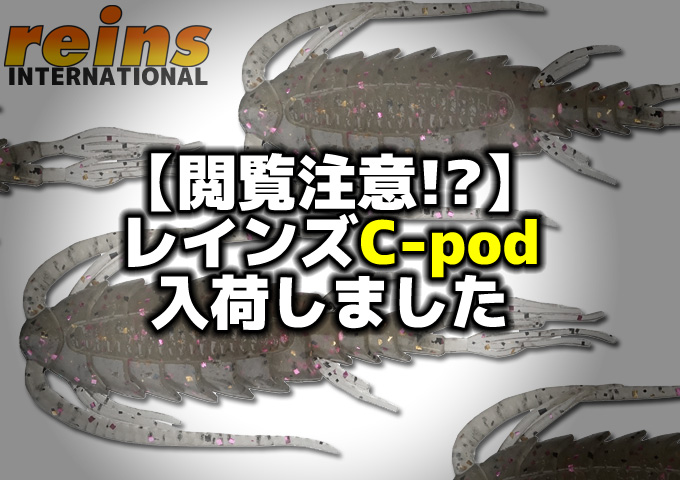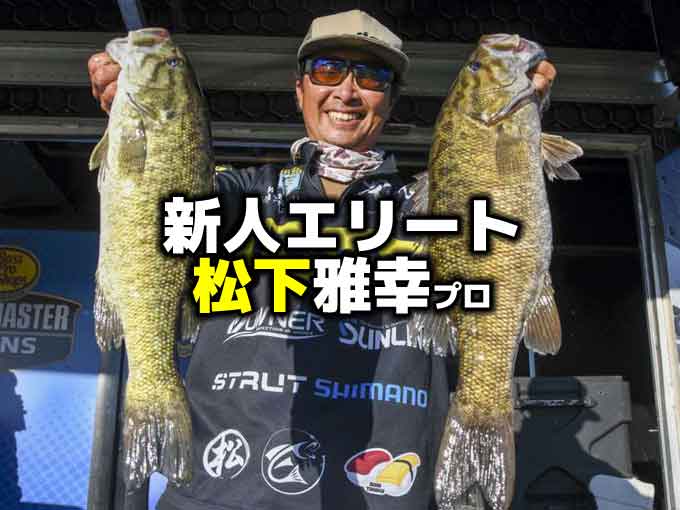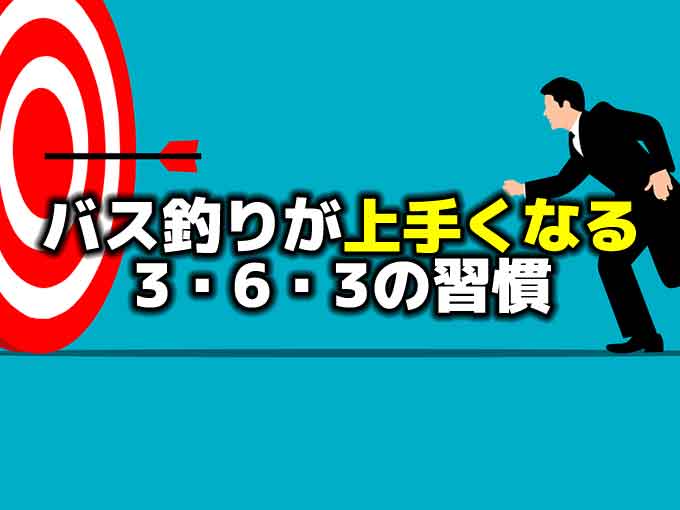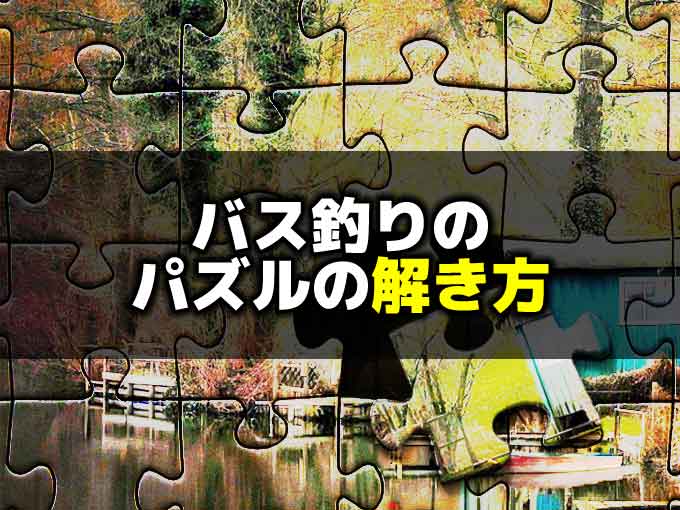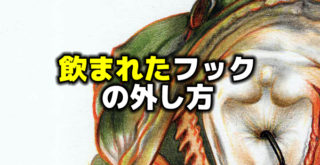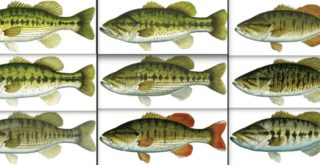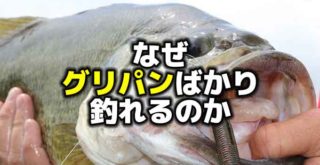アメリカンルアーヒストリー:ウッド(バルサ)ルアーの台頭

Photo by in-fisherman.com
こんにちは!店長の小山です!
本日は海外サイトより、”The Rise of Wood Lures”という記事を引用してご紹介いたします。
引用先:in-fisherman.com”The Rise of Wood Lures”by Steve Quinn February 27th, 2018 (海外サイトです)
皆さんは、ルアーの歴史について調べられたことはありますでしょうか。
ルアーの始まりとは何だったのか。一般的に知られているところでは、1800年代に、アメリカの親子が食事用のスプーンを川に落としてしまったら、トラウトがそこに食いついたというのが知られている話だと思います。
ただこれはゲームフィッシングとしてのルアーという意味であって、おそらく疑似餌という風に解釈を広げれば、もっとはるか以前からあったのではないかと思います。
例えば石器時代あたりでも釣り針のような形をしたものが発見されていると思いますが、あれそのものが石ですから、シンカーでもあり、模様もあり、針でもある、まさに疑似餌に近いものにも見えます。
それから動物の骨、ツノ、金属という風に変化してきましたが、そのように歴史を長い目で見たとき、意外にも、木という素材でできた疑似餌の登場は遅かったように思えます。
ではそのウッドルアーの歴史とは、実際どういったものだったのでしょうか。
この記事は、アメリカのフィッシングメディア「In-Fisherman」の記者スティーブ・クイン氏が書いたもので、ウッドルアーの起源と発展について書かれています。
プラスチックという最強の素材があるにもかかわらずいまだに作り続けられている木のルアー。これにはきっと秘密があるはずです。
歴史好きの方にも面白い内容だと思います。ぜひ読んでみて下さい。
ウッドルアーの台頭
In the early 1900s, our bassin’ forefathers were thankful for the introduction of exciting new lures. Seems James Heddon of Dowagiac, Michigan, had been whittling various hardwoods to create bass plugs. Wood lures cast far better than those of wire, sheet metal, and feathers, and had lifelike action on top and realistic swimming movements when cranked below the surface. His first design was a frog, carved from a pinewood broomstick. On its initial test a bass demolished it, so the story goes. In 1902, he applied for his first U.S. patent for his invention of ”new and useful improvements in fish-baits.” For the first decade, James Heddon and son Will produced surface lures. He introduced the Wiggle King in 1918, a shallow-diver, with the promo, “The wobble makes ‘em gobble.”
Success brought competition, notably three gentlemen from Garrett, Indiana, who founded the Creek Chub Bait Company and opened a factory in 1911. Just five years later, their Wiggler went into production with a metal diving lip that could be considered the world’s first lipped crankbait. The Wigglefish, credited with luring George Perry’s record largemouth in 1932, came a few years later.
Jumping ahead about 25 years and some 4,400 miles, Lauri Rapala, a commercial fisherman in Finland, fashioned a lifelike minnowbait from bark and foil, with a coating of melted photographic negatives. As the story goes, he caught more fish by trolling his delicately balanced, lipped lure than with gangs of trotlines baited with live minnows. After the end of World War II, he taught his four sons the art of luremaking and his business was born.
Rapala’s lures filtered across the sea, some acquired by Olympic athletes at the 1952 Summer Games. With its large Finnish population, the first lures became available in northern Minnesota in the late 1950s, attracting the attention of Ron Weber and Ray Ostrom, fishing tackle retailers who teamed up to import Rapalas in 1960. Eventually, Rapala became the world’s largest lure company.
1900年代初頭、私たちバスフィッシャーマンの先駆者たちがエキサイティングな新しいルアーの導入をしたことに感謝したいと思います。ミシガン州のDowagiac(ドワジャック)のJames Heddon(ジェームズ・ヘドン)は、バス用ルアーを作るためさまざまな硬材を削っていたようです。ウッドルアーは、ワイヤー系、スプーン、フェザーよりもはるかに優れたキャストを実現し、水面でのアクションや表層での巻きでもリアルで生き生きとしたアクションを起こしました。最初のデザインは、松のほうきの柄から削り出されたフロッグでした。最初のテストのときにバスがそれを破壊してしまったところから、この物語は始まります。彼は1902年に「使える新型ルアー」として発明した初の米国特許を申請しました。そこからの10年間、ジェームス・ヘドンと息子ウィルは表層系ルアーを作りました。彼らは1918年にシャローダイバーのWiggle King(ウイグルキング)を宣伝しました。“The wobble makes ‘em gobble.”(ウォブリングで食わす。当時の宣伝文句でしょうか)
その成功は競争をもたらしました。特に、インディアナ州ギャレットの3人の紳士がクリークチャブ・ベイトカンパニーを設立し、1911年に工場をオープンしました。わずか5年後、世界初のリップつきクランクベイトといえる金属リップ付きのWiggler(ウィグラー)の生産を開始しました。その数年後、1932年にジョージ・ペリーが記録的なラージ・マウスを釣ったルアーとなるウィグルフィッシュが登場しました。
フィンランドの商業的アングラー(メディアプロの先駆けともいえる)、Lauri Rapala(ラウリ・ラパラ)は、その約25年前と約4,400マイル先で、樹皮とアルミ箔で成型し、写真に使うネガフィルムをとかしたものでコーティングしたまるで生きているようなミノールアーを作りました。噂によると、彼は生きている小魚をつけて並べた「はえ縄漁」よりも、しっかりバランスのとれたルアーをトローリングで使うことでより多くの魚を捕まえたということです。第二次世界大戦の終結後、彼は4人の息子にルアーメイキングの技術を教え、彼のビジネスは生まれました。
1952年の夏季オリンピック(フィンランド:ヘルシンキオリンピック)に出場した釣り好きの選手たちが買って帰ったことで、ラパラのルアーは海を越えて知れ渡りました。 1960年にラパラのルアーを輸入するためにチームを結成したフィッシングタックル小売業者のRon WeberとRay Ostromによって、フィンランド人が多いことから、最初は1950年代後半にミネソタ州北部でルアーが入手可能となりました。最終的には、Rapalaは世界最大のルアー会社となります。
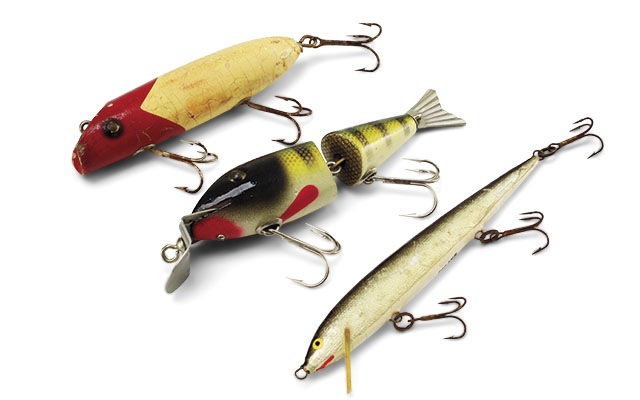
Photo by in-fisherman.com
バルサ材への取り組み
The Rapala family settled on balsa as the wood of choice to make Lauri’s minnow. Its buoyancy gave the lures a delicate flutter and quick rise to the surface that was like his original hand-crafted model. Today, Rapala continues to be a world leader in producing balsa lures, though they also make lures of various blends of plastic. The original lure, now called the Original Floating, is still one of the hottest sellers after some 77 years on the market. Mark Fisher, Director of Field Promotions for Rapala, says the Original Floater has withstood the test of time. “The #9 and #11 sizes remain as popular today as when they first became available to retail in the early 1960s,” he says. “Despite trends in lure color over the years, the original gold and silver models remain the best sellers, over a million pieces annually.”
All woods offer challenges to lure makers. Compared to plastic baits, it’s much harder to maintain tolerances, since hardness and moisture content vary among trees and even within parts of the same tree. If it wasn’t for the unique characteristics of the Central American balsa tree, no one would carve lures from it. But given its unique buoyancy and ability to make lures come to life, Rapala and many other companies, large and small, continue to use it.
“Rapala owns a series of balsa forests in Ecuador,” Fisher reports, “where we replant and rotate plots to maintain stable production. From there, the wood is sent to Finland where it’s graded. For lures with most delicate action, such as Shad Raps and Original Floaters, we use only wood from the core of the tree, where texture and density are most consistent. These characteristics vary more toward outer part of the tree, but that wood is fine for lures like crankbaits. Lures like the DT series of divers or the Tail Dancer exhibit powerful action that overcomes any minor variances in wood makeup. And that’s why it’s no problem to include a rattle chamber in those models.
“Trees are cut into working lengths, such as a 12-foot length that’s 1¼- X 1¼-inch, that are fed into lathes programmed for each model and size. After a series of steps, out come dozens of Shad Rap shapes, for example. Then precision saws cut slots for lips and hook hangers. After at least seven coats of clear coat and paint, they’re shipped to Estonia, where workers attach split rings and hooks and conduct final testing in 40 identical tanks. From tree to package, the process can take months.
”We’re often asked why we don’t make a balsa lure that suspends,” Fisher continues. “The fact is, it would be nearly impossible to produce a quality product of that sort. We’ve learned that it’s hard enough to make plastic lures that consistently suspend at various water temperatures. Given the variability of any wood, and particularly balsa, it would not be economically feasible, even if it was physically possible.”
About seven years ago, Rapala offered the first encapsulated lures, the BX Minnow and BX Swimmer, a jointed lure. “Basically, they’re balsa lures encapsulated by an outer plastic shell,” Fisher explains, “like an M&M. The outer plastic uses the balsa body for support. Sonic welding the left and right halves provide superior strength, as well as protection for the delicate balsa. The tolerances to manufacture these components have to be incredibly accurate for it all to fit perfectly.” He also revealed the upcoming introduction of the BX Brat, an encapsulated balsa bait with a square lip, available in two sizes.
Rapalaファミリーは、ラウリのミノーを作るために適した木材としてバルサに行き付きました。その浮力によって、ルアーは彼の手作りによるオリジナルモデルのような繊細なフラッターと急激な浮き上がりを得ました。今日、ラパラはプラスチックなどの様々な合成物からもルアーを作っていますが、バルサルアーの製造における世界的リーダーであり続けています。現在はオリジナルフローティングと呼ばれているオリジナルのルアーは、市場で約77年間もの人気を誇る商品の1つです。ラパラのフィールドプロモーション担当ディレクター、マーク・フィッシャーは、オリジナルフローティングは何年たっても色あせないと言います。 「#9と#11のサイズは、1960年代の初めに小売が可能になった頃と同じくらい人気を維持しています。 その年ごとのルアーカラーの流行りの傾向があるにもかかわらず、オリジナルのゴールドとシルバーのモデルは、毎年100万個を超えるベストセラーです」
ルアーメーカーはすべての木でルアーづくりに挑戦しています。プラスチック製のルアーに比べて、硬度と含水率は樹木によって異なり、また同じ木でも部分によって異なるため、許容差を維持するのは非常に難しいです。中米にあるバルサ材独特の特徴がなければ、誰もそこからルアーを削り出そうとはしなかったでしょう。しかし、独特の浮力とルアーが生き生きと泳ぐ能力があることから、ラパラと他の多くの企業は、引き続きそれを使い続けています。
「ラパラはエクアドルに一連のバルサ林を所有していますが、安定した生産を維持するためには再植えこみし、回転させる構想がなければならない。」とフィッシャーの報告書にはあります。そこから木材はフィンランドに送られ、そこで等級分けがされます。 Shad Rap(シャッドラップ)やOriginal Floaters(オリジナルフローター)のような繊細なアクションが必要なルアーでは、木の芯から樹皮まで密度が一貫している木材のみを使用します。これらの特性は通常は樹木の外側に向かって変化していきますが、クランクベイトのようなルアーにとっては問題ありません。ダイバーやテールダンサーのDTシリーズのようなルアーは、ウッド製による小さな製品ムラを克服する強力なアクションがあります。そして、それらのモデルにはラトルルームを設けることも問題ではありません。
「木は、たとえば長さ12フィートのものから1.25×1.25インチの長さにカットされ、各モデルとサイズ用にプログラムされた旋盤に送られます。その一連のステップの後、たとえばShad Rapの形に数十個出されます。その後、精密ノコギリによりリップとフックハンガーの切れ込みを削ります。クリアコートとペイントなど少なくとも7回のコーティングの後、エストニアに出荷されます。エストニアでは、作業員がスプリットリングとフックを付けて、40の同じ水槽で最終テストを行います。木材から製品になるまで、そのプロセスには数カ月かかることがあります。
「なぜバルサ製のサスペンドルアーを作らないのか、よく聞かれます。」フィッシャー氏は続けます。 「実際、そのような高品質の製品を生産することはほぼ不可能です。我々は、様々な水温下で常にサスペンドするプラスチックルアーを作るのすら難しいことを学びました。木材、特にバルサ素材のばらつきを考えると、物理的に可能であっても、経済的に実現可能ではないのです。」と語りました。
約7年前、Rapalaは最初のカプセル封入されたルアー、BX Minnow(BXミノー)とBX Swimmer(BXスイマー)を発売しました。 「基本的に、それは外側のプラスチックによりカプセル化されたバルサのルアーです。」フィッシャーは言います。「M&Mのように、外側のプラスチックはバルサ素材のサポートのために使用します。左と右の半分ずつをソニック溶接することで、繊細なバルサを保護するだけでなく、優れた強度を提供します。これらのコンポーネントを製造する際の許容誤差は、完全に適合するように信じられないほど正確でなければなりません。」と述べています。彼はまた、BX Bratという、スクエアリップのカプセル系バルサルアーを2サイズ発表しました。
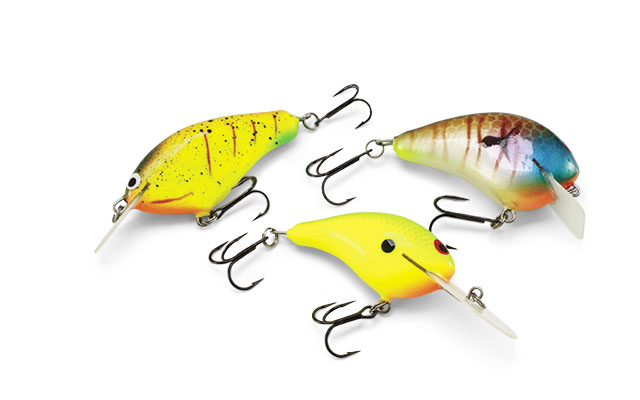
Photo by in-fisherman.com
カスタムルアー
“I was always a balsa nut,” admits Phil Hunt, owner of PH Custom Lures as well as his Old School Balsa Baits brand. “Along with fishing, I began crafting them as a hobby. I got to know Lee Sisson who designed lures for Bagley Bait Company and he helped me out.” After anglers gave his custom balsa lures a positive response, he retired from his career as a paramedic and went full-time three years ago. “The custom lure business has gotten huge,” he says. “I recently built a new building and just hired four new people. The bulk of our business is in balsa, but I make several topwater lures of the Malaysian wood, jelutong, and also have added some resin lures.
“It’s hard work and I’m not getting rich. And I don’t get much time to fish anymore,” he rues, “but it’s rewarding to get so much great feedback from anglers.” Hunt offers two lure lines of balsa baits, both from select-grade wood. PH Custom Lures are more labor-intensive, with circuit-board lips, premium VMC hooks, special painting and drying treatments, and are air-brushed in multiple hues by Hunt himself. One layer of clear coat has a UV inhibitor to prevent fading. They’re also hand tuned in a tank and guaranteed to hunt right and left, out of the box. Production requires 41 steps and takes two weeks to complete a lure. They retail from $23 to $25.
Old School Balsa Baits also are hand-made and hand-painted, and have VMC hooks. Dipping and painting are not as extensive as with the Custom Lures and lips are polycarbonate, except for the Wesley Strader Series, which have circuit-board lips. They may need minor tuning and retail for $10 to $14. “It’s interesting that I sell almost 10 times more of the Custom Lures than the Old School models,” he says. “I have tens of thousands of these lures going out the door, and each year is bigger.”
「私はいつだってバルサ愛好家です」と、PH Custom LuresとOld School Balsa Baits(オルドスクール・バルサベイツブランド)のオーナーであるPhil Hunt(フィル・ハント)も認めています。 「釣りとともに、趣味として作り始めました。バグリー社のルアーデザイナーLee Sisson(リー・シッソン)と知り合い、彼は私を助けてくれました。」その釣り人がカスタム・バルサにポジティブな印象を抱かせた後、彼は救急医療の仕事から退いて3年前に専任になりました。 「カスタムルアー事業は巨大化しています。 私は最近、新しいビルを建て、4人の新しい人を雇いました。私たちのビジネスの大部分はバルサにありますが、私はマレーシアウッドのジェルトンでいくつかのトップウォータールアーを作っており、いくつかの樹脂ルアーも加わっています。」
「これは激務であり、金持ちにもなれません。そして、私はもはや釣りに行く時間もあまりありません。」と彼は言います。「しかし、釣り人たちから多くのフィードバックを得ることは価値があります。」 ハントは選ばれた等級の木材から2種類のルアーラインでバルサルアーを提供しています。 PHカスタムルアーは、サーキットボードのリップ、プレミアムVMCフック、特殊な塗装、乾燥処理など、より労働集約的であり、ハント自身によって複数の色でエアブラシ処理されています。クリアコートの1つの層は、退色を防ぐためにUV抑止剤を使っています。彼らはまた、タンク内でハンドチューンし、箱から出した時点で左右に寄らないことが保証されています。生産には41のステップが必要で、ルアーを完成させるには2週間かかります。彼らは$ 23から$ 25で小売りされています。
Old School Balsa Baitsは手作りで手塗りで、VMCフックも装備しています。ディッピングや塗装はカスタムルアーと同じような広範囲ではなく、リップはポリカーボネートですが、サーキットボードのリップを持つWesley Strader(ウェズレイ・ストラダー)シリーズは例外です。少しのチューニングを必要とするため小売は10〜14ドルです。 「オールドスクールのモデルよりも約10倍もカスタムルアーを販売しているのは興味深いことです。」と彼は言います。 「いまや数万のルアーを持ち、独立してから毎年大きくなっていきます。」
生まれ変わったバグリー
Entering the tackle business in 1954 with a line of pork rind, Jim Bagley of Florida became intrigued with balsa lures, including the sensational new Rapala or Finnish Minnow.
He recognized its light and lively action as key to attracting bites, and he also wished to increase lure weight slightly to allow easier casting. His Bang-O-Lure first offered in the early 1960s was a great success, as were his diving lures, the Diving B, Balsa B, Small Fry Series, and more. Pros and weekend anglers embraced the brand and Bagley baits accounted for four Bassmaster Classic wins in the 1980s.
Bagley sold the company in 1998, and several groups and individuals owned the brand over the next 12 years. Anglers complained that favorite styles didn’t match the old ones, and the classics were treasured by pros and collected. Today, some rare models sell on eBay for over $1,200.
In 2010, Jarmo Rapala, grandson of Rapala’s founder and former CEO of the Rapala Group, along with a new ownership group, bought the company and began to reenergize the brand. As an admirer of Jim Bagley for his attention to quality and product ingenuity, the younger Rapala incorporated a new production process and quality control, with Don Hultstrand, a former Rapala executive, as president.
The centerpiece of the new production model is Heat Compression Molding (HCM), a multi-step process that yields a consistent top-quality lure. “After balsa wood from Ecuador is brought to the factory in Serbia, it’s cut to specified lengths and widths,” Hultstrand says. “The balsa then goes into a CNC router where lure bodies are formed, then they’re sectioned in half, lengthwise.
“The balsa halves are then placed in a heated metal mold and compressed together. Heat causes the body to shrink and the grain to tighten, resulting in a smooth and harder exterior and a truer consistency in lure weight. This allows use of fewer layers of clear coat and paint, keeping it more buoyant as well as creating a harder exterior.
“The HCM process also carves internal channels where pieces of lead are positioned, along with a wire harness for hardware. The halves then are joined and sealed, hand-sanded, then primed and painted. Finally, they’re tank-tested to ensure alignment of the lip and eye. This process means that each lure is precisely weighted and balanced to achieve the subtle action designed into each one.” In addition to classic designs like Diving B2, Bang O Lure, Crawfish, and Small Fry, new models include the Balsa Shad, Balsa Minnow, Rumble B, and Sunny B, as well as a couple of new surface lures. Thanks to the efficiency of the new process, they retail from $7 to $9.
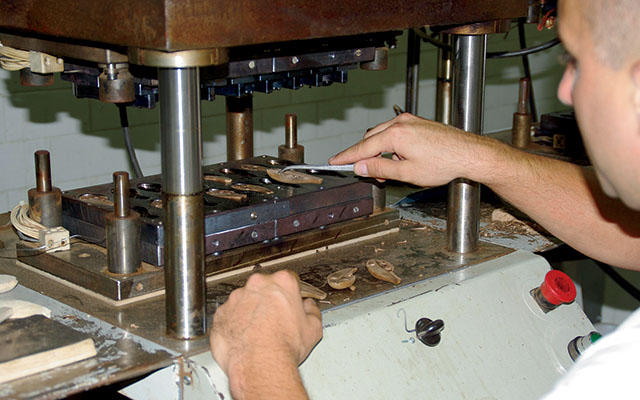
Photo by in-fisherman.com
1954年にポークリンドを使ってタックル事業に参入したフロリダ州のジム・バグリーは、センセーショナルな登場をしたRapalaやフィンランドのミノーなど、バルサのルアーに興味をそそられました。
彼はその軽く活発なアクションがバイトを引き寄せる鍵と判断しつつも、魅力的なキャストを可能にするためにルアーの重量を少し増やしたいと考えました。1960年代初めに最初に発売されたBang-O-Lureは、他のダイビングルアーであるダイビングB、バルサB、スモール・フライ・シリーズよりも大きな成功を収めました。プロやサンデーアングラーまでもがこのブランドを受け入れ、バグリーのルアーは1980年代のBassmaster Classicで4勝をもたらしました。
バグリーは1998年に同社を売却し、その後12年間はいくつかのグループと個人がブランドを起ち上げました。しかし釣り人からは、古くからのお気に入りのスタイルと一致しないと不満を言い、古いモデルはプロたちによって集められました。今日、いくつかの稀少モデルはイーベイなどで$ 1,200以上で販売されています。
Rapalaの創業者でありRapalaグループの元CEOの孫であるJarmo Rapala(ジャーモ ラパラ)氏は、2010年に新しいオーナーシップグループとともに同社を買収し、ブランドの再活性化を開始しました。品質と製品の創意工夫への彼の関心のためにジム・バグリーのファンとして、ラパラ青年は元ラパラの幹部であったDon Hultstrand(ドン・ハルトストランド)と新しい生産プロセスと品質管理を社長として取り入れました。
新しい生産モデルの中心は、一貫した最高品質のルアーをもたらす多段階プロセスである熱圧縮成形(HCM)です。 「エクアドルのバルサ材をセルビアの工場に持ち帰り、指定された長さと幅にカットされています」とハルトストランド氏は言います。「バルサ材は次にルアーボディーが形成されるCNCルーターに入れられ、縦に半分に切断されます。」
バルサ半分を加熱された金型に入れ、一緒に圧縮します。熱によってボディが収縮し、少量に縮みます。滑らかでより硬い外殻と、ルアー重量のより真正な均一性をもたらします。これにより、クリアコートと塗装の層を少なくし、より浮力があり、より硬い外殻を作ることができます。
また、HCMプロセスは、ハードウェア用のワイヤーハーネスとともに、鉛のウエイトが配置される内部チャネルを彫っています。半分は接合され、密封され、手作業で研磨され、重要な塗装をされます。最後に、リップとアイの位置合わせを確実にするために水槽実験を受けます。このプロセスは、それぞれのルアーが正確にウエイト付けされバランスがとられ、それぞれに微妙なアクションを実現しています」ダイビングB2、バング・オー、クローフィッシュ、スモールフライのようなクラシックなデザインに加えて、Balsa Shad(バルサシャッド)、Balsa Minnow(バルサミノー) 、Rumble B(ランブルB)、Sunny B(サニーB)などの新しいルアーを追加しました。新しいプロセスの効率のおかげで、それらは$ 7から$ 9で小売りされます。
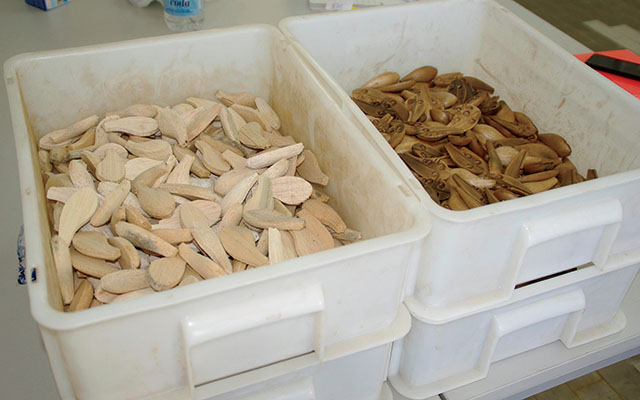
Photo by in-fisherman.com
It should be no surprise that wood lures are at home among the trees. We recognize the importance of contacting cover when fishing crankbaits. The collision causes the lure to veer off to one side, then return to center. There’s something about this motion that seems to imitate the erratic kick often exhibited by a wounded baitfish.
While rocks offer a target for banging, standing timber offers cover at a range of depths. Remaining limbs are bass magnets but now are scarce in our aging reservoirs. Often only stumps remain, especially in impoundments that fluctuate frequently in water level.
“It’s a challenge for even expert casters angler to hit such a target on a long cast,” says David Fritts, who has pocketed well over a million dollars in tournament winnings with his crankbait acumen. Over the years, he’s worked with Poe’s cedar crankbaits, and was closely involved with development of Rapala’s ever-popular DT lineup. He’s recently worked with Berkley to create a large series of plastic crankbaits, incorporating the appeal of wooden baits with the practicality and advantages of plastic. From the mid-1990s to 2008, he dominated numerous tournaments where he dialed in a deep cranking pattern with Rapala DT10, DT16, and DT20 divers, targeting individual pieces of cover from 10 to 20 feet deep. When he got dialed in, he not only won events, but often crushed the field by 10 pounds or more.
“You’re basically trying to put that lure into a 2-foot by 2-foot window, at a distance of maybe 35 yards,” he says. “The art of triangulating spots has been almost lost, with new GPS applications. But if you mark a stump you pass over, you need another marker to define where to cast from. Many of us old-time crankers would line up tall trees, barns, or bridge abutments to locate offshore spots, sometimes no more than a stump or two or a big rock in 12 to 15 feet of water. We’d sketch drawings of the location, with notes on angles, distance, compass orientation, and depth.
“Today, side-imaging makes it easier, since you can spot a stump from 80 feet away and pop a waypoint on it. As long as you clearly label your waypoints, you can approach from any angle and get pretty close. Still it may take half a dozen casts to contact such an object. Moreover, the best deflection comes when a lure is traveling in open water and bangs into it, creating a sudden turn and momentary change in direction. It doesn’t work as well if you root along the bottom, then bump into the cover.”
Fritts has always been a fan of low-geared baitcasters for his deep work, originally the Lew’s Speed Spool with a 4.7:1 ratio. “You need to let the lure do its work,” he says. “Once it gets down there, let it hunt and bump at a pace that makes it easy for a bass to eat it.” In contrast to the frenzied pace of many of today’s pro anglers, Fritts fishes deliberately, with a mental image of the cover as he dissects it with his crankbait. He believes an angler’s feel of a lure is enhanced with a slow, steady retrieve.
ウッドルアーをウッドカバーの中に入れて行くのは驚くべきことではありません。我々はクランクベイトで釣る際にはカバーに接触することの重要性を認識しています。なにかと衝突することにより、ルアーがどちらかに逃げるようになり、中央に戻る。この動きは、負傷したベイトフィッシュが頻繁に見せる不規則な動きを模倣しているのです。
岩も当てていくものの対象となりますが、立木は深さのあるカバーです。枝にもバスを引きつける力がありますが、古くからあるリザーバーでは枝は残っていません。また特に水位が頻繁に変動するリザーバーでは、数え切れないほどのスタンプが残っていることがあります。
「ベテランアングラーでも、ロングキャストでそんな目標を狙うのは難しいことです。」と、クランクベイトへの鋭い洞察力で100万ドルを超えるトーナメント賞金を収めているデビッドフリッツ氏は言います。長年にわたり、彼はPoe’s(ポー)のcedar crankbaits(セダークランクベイト)を使っており、Rapalaで人気のDTラインナップの開発に密接に関わっていました。彼は最近、バークレーと協力してプラスチック製のクランクベイトを大量生産し、そこでウッドルアーの良さをプラスチックルアーの実用性の中に取り入れました。 1990年代半ばから2008年にかけて、彼はRapala DT10、DT16、DT20ダイバーというそれぞれを10〜20フィートのレンジにあるカバーに向けるディープクランキングパターンを用いて多くのトーナメントを制覇しました。それがうまくいったとき、彼は試合に勝っただけでなく、しばしばそのフィールドから10ポンドオーバーを抜きあげました。
「基本的には、だいたい30メートル先の60センチ×60センチの範囲にルアーを投げ込もうとします。 三角測量の技術は、新型GPSの前ではほとんど失われています。しかし、あなたが通したいスタンプにマーキングするときは、どこからキャストするかという別のマーカーも必要になります。昔のクランカーたちは、沖合のポイントの場所を覚えるために背の高い木、小屋や橋脚の並びで覚えることがありました。時には水深4~4.5メートルにあるたった2つのスタンプや大きな岩をです。私たちは、角度、距離、方位、深さについてのメモをとり、場所を図にしてスケッチしていました。」
「今日では、25メートル離れたところからスタンプを見つけてそこにウェイポイントを付けることができるなどサイドイメージがあれば簡単にできます。ウェイポイントがはっきりとしているかぎり、どのような角度からでも接近して近づくことができます。それでも、このようなカバーに当てるには多くのキャストが必要になるかもしれません。さらに、最高のシチュエーションとしては、ルアーがオープンウォーターを移動してカバーに当たって、急な方向転換と瞬間的な変化をもたらしたときです。底を叩きながら進んでカバーにぶつかっても、うまくいかないのです。」
フリッツは、ディープクランクを使うときはローギアのベイトリールを使っており、当初からギア比4.7:1のLew’s(ルー)のスピードスプールのファンでした。 「ルアーに仕事をさせる必要があるからです。」と彼は言います。 「そこまで潜らせ、それをバスに襲わせ、食べられる。そんなペースが簡単に作り出せるのです。」今日のプロの釣り人の多くの激しいペースとは対照的に、フリッツのクランクベイトは丹念に探っていきます。彼は、釣り人のルアーへの感触とは、ゆっくりとしたステディリトリーブで強化されると信じています。
スピードの必要性
Of course, shallow square-bill bangers are most effective when bounced off cover, too. The Original Big O, carved of balsa by Fred Young in 1967, was the first true square-bill. It gradually developed a cult following and within 10 years, avid crankers were paying up to $20 for one. Cotton Cordell bought Young’s patent and made the lure of hard plastic.
But with the change in material and new models from competing companies like Norman Lures, Bagley Baits, Rebel Lures, and more, the Big O had lost its magic. But square-bill crankbaits continue to be one of the hottest lure categories as companies design new models of wood and plastic, knowing that in the right cover conditions and in the hands of experienced anglers, nothing can match their fish-catching ability.
As Young always pointed out, one of the keys to the square-bill is a fast retrieve that keeps it wiggling and bouncing through cover, deflecting and returning to center. His choice of balsa meant the lure’s buoyancy helped it keep from snagging. Veteran shallow crankers develop a keen sense of feel to tell the difference from a treble hook starting to bury in a branch and a bass bite. In the case of the former, momentarily stopping the retrieve and pushing the rod toward the lure allows it to back off the cover. The buoyancy of balsa helps greatly in this regard. A firmer stoppage generally means a fish, and a hook-set is a mere sideways pull of the rod.
But most experts don’t rely on fast reels for such fishing. Cranking ace Rick Clunn favors models with a retrieve ratio of 6.1:1 to 6.3:1. “The old 5:1 models we used to use are not fast enough. But with reels having a ratio of 7:1 or higher, you’re fighting the lure’s pull too much and losing sensitivity of what it’s doing,” he says.
Combining the natural appeal and traditional values of wood lures with today’s new technology and worldwide trade agreements brings anglers wonderful lures of new and old designs. Enjoy them for their tradition, their looks and feel, and most of all the bass they catch.
もちろん、シャロースクエアビルクランクが、カバーに当たって跳ねたときが最も効果的です。 1967年にフレッド・ヤングがバルサを削って作った「オリジナル・ビッグ・オー」が、最初の真のスクエアビルクランクでした。それが10年以内に次第にエスカレートし、熱心なクランカーたちは1個20ドルも支払っていました。コットンコーデルはヤングの特許を購入し、プラスチックのルアーを製造しました。
しかし、Norman Lures(ノーマン)、Bagley Baits(バグリー)、Rebel Lures(レーベル)などの競合企業の新素材とモデルチェンジの前に、ビッグ・オーはその魔力を失いました。しかしスクエアビルクランクベイトは、メーカーがウッドやプラスチックでニューモデルをデザインする際、最も魅力的なカテゴリーの1つであり続けています。経験豊かな釣り人には、これでなければ獲れない魚がいることが分かっています。
ヤングが常に指摘していたように、スクエアビルの鍵の1つは、ファストリトリーブのときのウィグリング、カバーに当てた時の跳ね返り、また中央に戻って続けることです。彼がバルサ材を選ぶということは、ルアーの浮力が根掛かり回避の役に立つことを意味しました。ベテランのシャロークランカーは、トレブルフックがカバーに引っかかりそうな時とバスのバイトを見分ける鋭い感覚を持っています。前者の場合、一時的にリトリーブを停止し、ロッドをルアーの方に戻すと、カバーをかわすことができます。この点において、バルサの浮力が大きく貢献します。よりしっかりした抵抗感はだいたい魚を意味し、フックセットはロッドを横方向に引っ張るだけです。
また、ほとんどのプロは、この釣りにはハイスピードリールに頼っていません。 クランキングのエース、リック・クランはギア比6.1:1〜6.3:1のモデルを好んでいます。 「私たちが使っていた古い5:1のモデルはたしかに遅すぎます。しかし、ギア比が7:1以上であれば、ルアーの抵抗との戦いが過度になり、何をしているのかの感受性が失われてしまいます。」
ナチュラルアピールと伝統という価値を持つウッドルアーを今日の新技術と世界的な流通と組み合わせることにより、釣り人に古くて新しいデザインをもたらします。その伝統、ルックス、雰囲気、そしてそれらがキャッチするバスのすべてを楽しんでください。
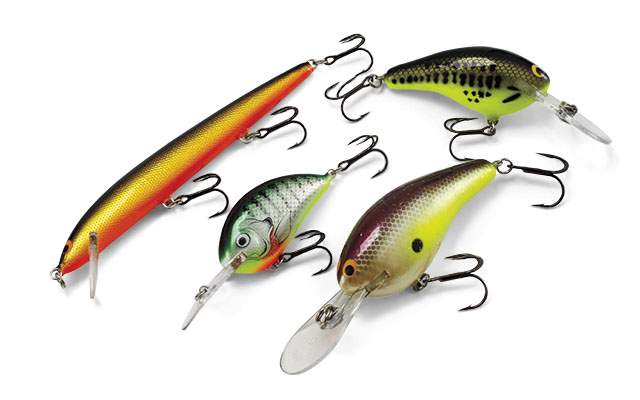
Photo by in-fisherman.com
いかがでしたか。
製品の均一化が比較的簡単なプラスチックのルアーができるまで、プラグの主な素材はウッドだったわけですが、これを読んでみると私が思っていた以上にウッドで製品の均一化を図るのは難しかったのですね。
ひと昔前のアメリカのルアーにはまあまあ製品ムラがあり、「当たりルアー、ハズレルアー」などと仲間内で気軽に言っていましたが、その苦労をこうして知ってしまうと、なんだかとても失礼なことを言っていたような気になってしまいました。
ただ、昔のアメルアーは、それも含めて非常に愛着の持てるといいますか、なにか特別なものを持っている気がします(笑)
そして今、SNSを見ていると若い世代のアングラーさんたちもログやバルサBやキラーBをアップしていることがあったりして、とても嬉しく思ったりします。
もしかしたら誰かが紹介した影響でちょっとした流行になっているだけなのかもしれませんが、こういう、ずっと昔から変わらないというものには何かあると、感じてそれを手にしたのなら素晴らしいなと思います。
いくらファミレスが近くにできても、昔から潰れずにやっているボロくて薄汚い食堂に入ってみたら、そこがやたら美味いのと同じで、昔から変わらず残っている物にはかならず理由があります。
だいたい、本人がやめたくても周りがそれを許さないというパターンが最高においしい食堂…えっとルアーの話でしたっけ(笑)
そういうものがあるんですよね。
これは昔からあるのもがいいものだというオジサン的な話ではなくて、今ある国産ルアーのなかにも30年間何も変わらないものだってきっとあるわけで、それは昔からあるルアーが今もあるように、30年経ってみないと分からないんです。
そういう、見る目を養うといいますか、ピーンと来たものに手を伸ばす事がいいんじゃないかと思うということなんです。
私にルアーを見る目があるわけじゃないんですけど、全然知らないルアーだけどなんか釣れそうな気がする、と言って買ったルアーはやっぱり一生懸命使っちゃうんですよね。
一生懸命使うので、釣れるとわかればそのまま1軍でOKですし、釣れないと分かった時に「これは釣れない」と思います。当たり前ですけど(笑)
釣れないというのは絶対的に釣れないという意味ではなくて、自分のスタイルや使い方には合わないという意味です。
そしてこれの繰り返しで、釣れるルアーが分かってくるんです。メーカーの宣伝文句に踊らされない、自分に合ったルアーですので、釣りが上手くなると思います。それが楽しい、みたいな。
私のようなおじさんには、アメルアーで釣るとなんだか単純に嬉しいみたいな感じなんですけどね、あれなんなんでしょうね(笑)
色々書いてしまいましたが、結局は楽しければいいと思うので、皆様にお任せするだけなんですけどね。
ぜひ釣って楽しいルアーを、自分の目で、探してみて下さい。
えらい長い文で疲れちゃいましたね、2回に分ければよかったですかね。すみません。
それでは、また。
毎度ありがとうございます!






